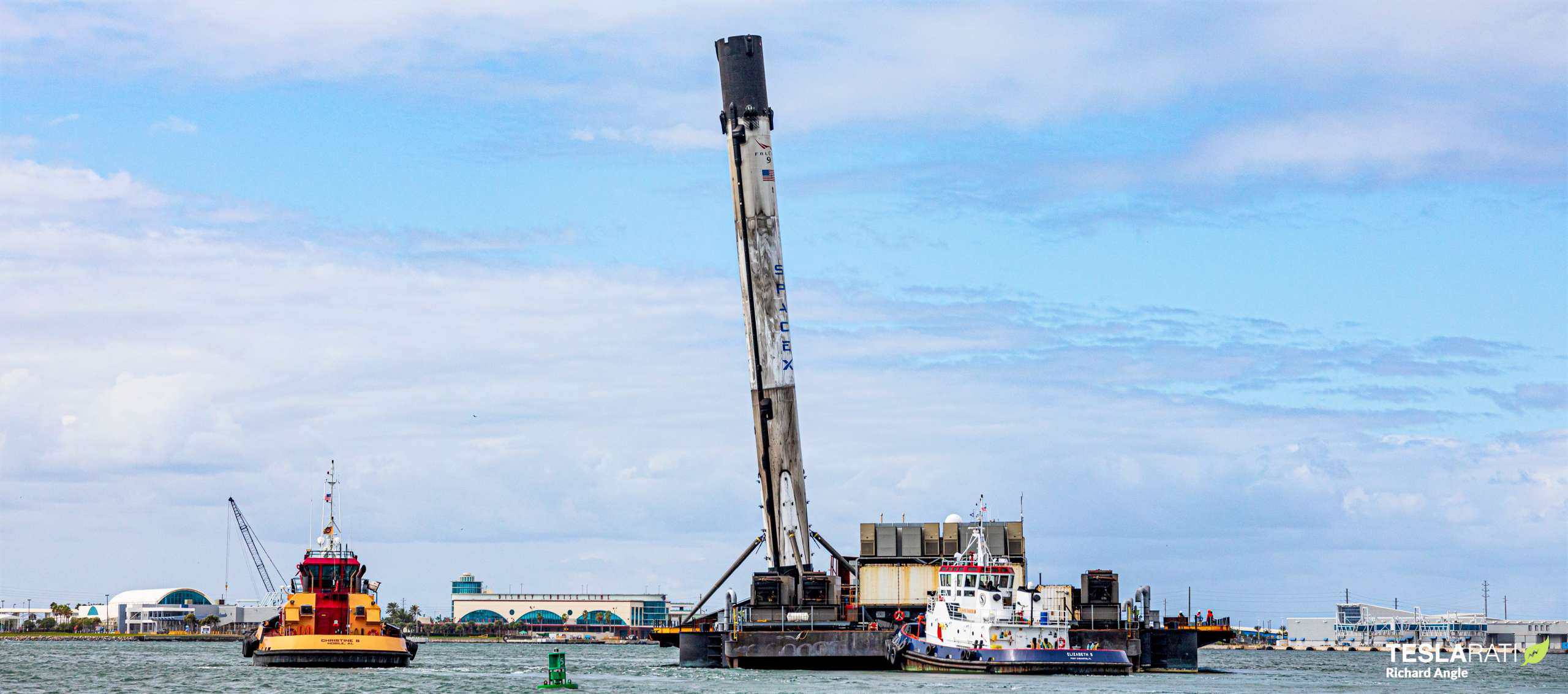
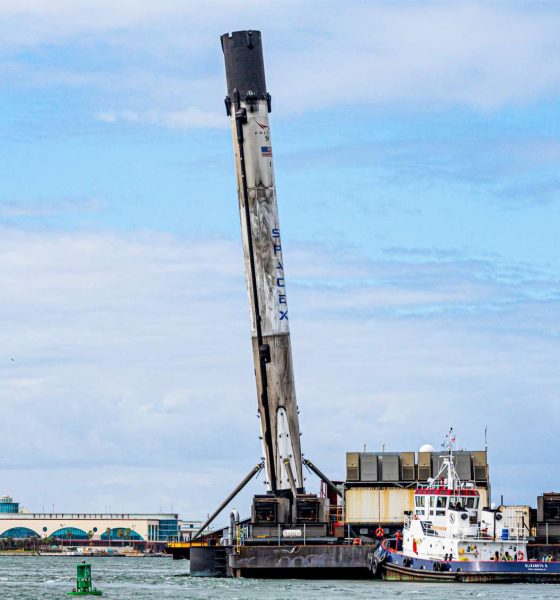
News
SpaceX’s most important Falcon 9 booster yet returns to port with a lean
On November 19th, what is likely SpaceX’s most important Falcon 9 booster yet returned to Port Canaveral with a surprise – perhaps the most dramatic lean ever observed on one of the recovered rockets.
Tilted a solid 10+ degrees from vertical, the lean was immediately visible as soon as the top of the rocket crest the horizon, and it later became clear that one of Falcon 9 booster B1061’s four landing legs had no contact at all with drone ship Just Read The Instruction’s (JRTI) deck. Four days prior, Falcon 9 (and B1061) became the first commercially-developed rocket in history to be certified to launch NASA astronauts, a feat it pulled off flawlessly. Crew Dragon safely delivered four astronauts to the International Space Station on November 16th, marking the culmination of more than half a decade of (mostly) uninterrupted work.
Even before Crew Dragon and Falcon 9’s momentous Crew-1 launch, though, NASA had already revealed some details that would make parts of Crew-1 even more important and the follow-up Crew-2 launch – scheduled as early as March 2021 – perhaps the most significant mission in SpaceX’s history.
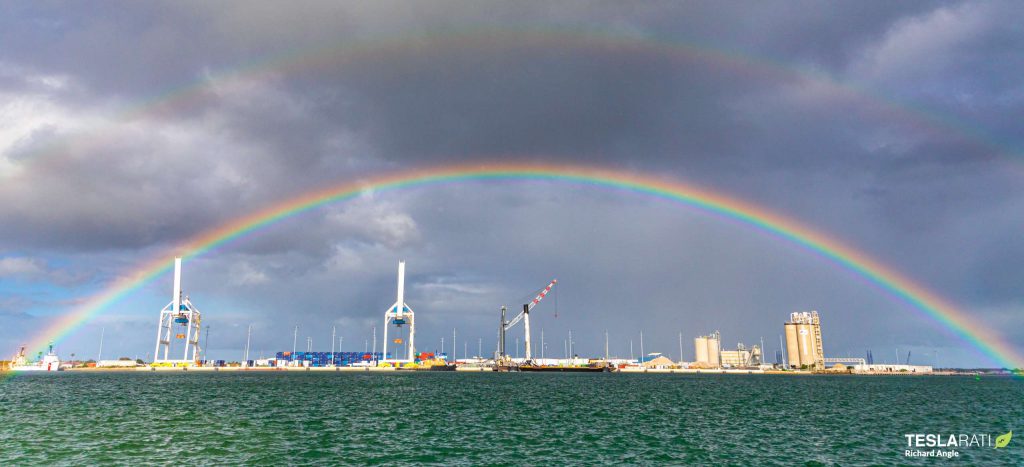
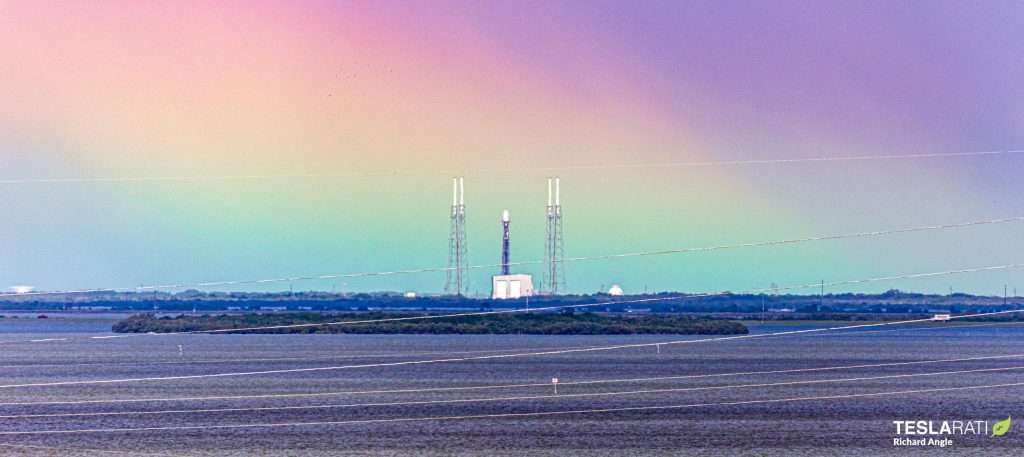
In short, less than a month after SpaceX’s equally flawless Crew Dragon Demo-2 astronaut launch debut, NASA contract modifications revealed that the agency had permitted SpaceX to reuse both Dragon capsules and Falcon 9 boosters on upcoming astronaut launches.
“In a wholly unexpected turn of events, a modification to SpaceX’s ~$3.1 billion NASA Commercial Crew Program (CCP) contract was spotted on June 3rd. Without leaving much room for interpretation, the contract tweak states that SpaceX is now “[allowed to reuse] the Falcon 9 launch vehicle and Crew Dragon spacecraft beginning with” its second operational astronaut launch, known as Post Certification Mission-2 (PCM-2) or Crew-2.”
Teslarati.com — June 9th, 2020
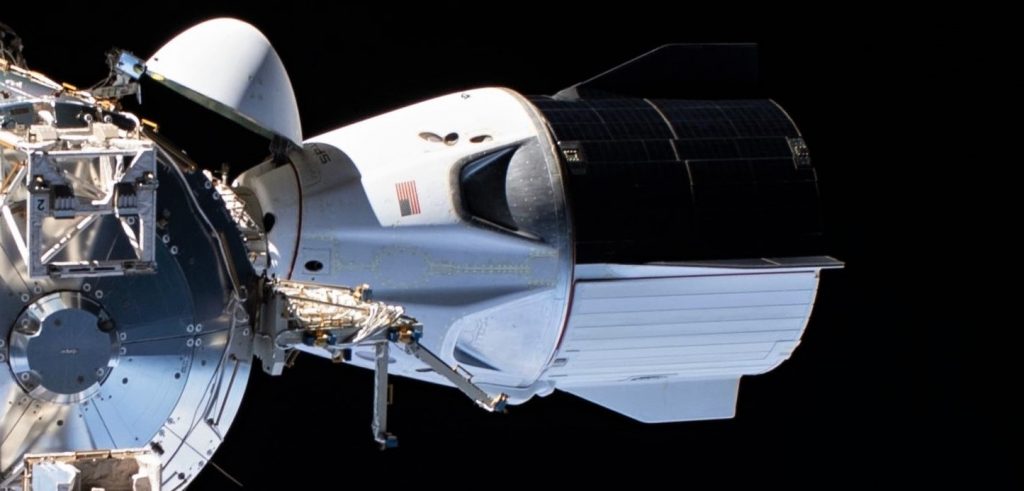
A few short months after that discovery, NASA itself specifically announced that it had given SpaceX the go-ahead to reuse Demo-2 Crew Dragon capsule C206 and Crew-1 Falcon 9 booster B1061 on Crew-2, the company’s second operational astronaut launch. Scheduled no earlier than March 31st, 2021, Crew-2 will most likely launch before the Crew-1 Crew Dragon departs the space station and returns its four crew members to Earth, a milestone expected sometime in April.
For almost anyone who has followed NASA’s Commercial Crew Program (CCP) and its attitude towards SpaceX’s reusability efforts from the beginning, the space agency’s rapid willingness to trust its most important cargo – humans – to flight-proven Dragons and Falcon 9 boosters came as a huge surprise. If SpaceX is able to reuse both capsule C206 and booster B1061 as planned, Crew-2 will without a doubt be the most significant milestone in commercial spaceflight history, simultaneously proving that astronauts can be safely launched on commercial flight-proven rockets and spacecraft.



Of course, while Demo-2 Crew Dragon capsule C206 may have already been successfully recovered, SpaceX still had to land Falcon 9 booster B1061 and safely return it to port after Crew-1 before it could consider reusing it on Crew-2. Based on the rocket’s appearance upon its arrival at Port Canaveral, B1061 had an extremely close call. With what can be intuited from observation alone, it appears that sometime after B1061 landed and before the drone ship’s tank-like ‘Octagrabber’ robot could secure the booster, a stray swell or sudden burst of high seas must have bucked Just Read The Instructions about, causing B1061 to slide around on the slippery deck.
That would explain why the Falcon 9 first stage arrived in port on one of the far corners of drone ship JRTI – also sign that B1061 likely hit the yellow barrier included specifically to prevent boosters from sliding off drone ship decks. At the same time, B1061 must have had a moderately rough landing, causing at least one of its four legs to expend a large portion of a single-use shock absorber called a “crush core,” leaving the booster sitting at an angle. Based on photos of the arrival, that tilt likely left JRTI’s Octagrabber unable to latch onto all four of Falcon 9’s hold-down clamps, forcing recovery technicians to improvise and manually chain the rocket to the deck where the robotic solution fell short.


Thankfully, the SpaceX recovery team’s apparent heroics and luck proved to be enough and the sturdy Falcon 9 booster was returned to dry land without issue, lifted off of JRTI’s deck around 24 hours after arriving in port. Based on photos of the crush cores at the bottom tip of each leg, B1061’s rough landing and eventful journey was fairly mild as far as they come and, as CEO Elon Musk notes, crush core replacement is likely all that’s needed to make the rocket good as new.
Had B1061 been lost at sea, Crew-2 would have almost certainly been delayed to give SpaceX enough time to come up with an entirely new Falcon 9 first stage. Luckily for SpaceX, that didn’t happen and the company’s plans to launch astronauts on the flight-proven booster are still in play.

News
Tesla aims to combat common Full Self-Driving problem with new patent
Tesla writes in the patent that its autonomous and semi-autonomous vehicles are heavily reliant on camera systems to navigate and interact with their environment.

Tesla is aiming to combat a common Full Self-Driving problem with a new patent.
One issue with Tesla’s vision-based approach is that sunlight glare can become a troublesome element of everyday travel. Full Self-Driving is certainly an amazing technology, but there are still things Tesla is aiming to figure out with its development.
Unfortunately, it is extremely difficult to get around this issue, and even humans need ways to combat it when they’re driving, as we commonly use sunglasses or sun visors to give us better visibility.
Cameras obviously do not have these ways to fight sunglare, but a new patent Tesla recently had published aims to fight this through a “glare shield.”
Tesla writes in the patent that its autonomous and semi-autonomous vehicles are heavily reliant on camera systems to navigate and interact with their environment.

The ability to see surroundings is crucial for accurate performance, and glare is one element of interference that has yet to be confronted.
Tesla described the patent, which will utilize “a textured surface composed of an array of micro-cones, or cone-shaped formations, which serve to scatter incident light in various directions, thereby reducing glare and improving camera vision.”

The patent was first spotted by Not a Tesla App.
The design of the micro-cones is the first element of the puzzle to fight the excess glare. The patent says they are “optimized in size, angle, and orientation to minimize Total Hemispherical Reflectance (THR) and reflection penalty, enhancing the camera’s ability to accurately interpret visual data.”
Additionally, there is an electromechanical system for dynamic orientation adjustment, which will allow the micro-cones to move based on the angle of external light sources.
This is not the only thing Tesla is mulling to resolve issues with sunlight glare, as it has also worked on two other ways to combat the problem. One thing the company has discussed is a direct photon count.
CEO Elon Musk said during the Q2 Earnings Call:
“We use an approach which is direct photon count. When you see a processed image, so the image that goes from the sort of photon counter — the silicon photon counter — that then goes through a digital signal processor or image signal processor, that’s normally what happens. And then the image that you see looks all washed out, because if you point the camera at the sun, the post-processing of the photon counting washes things out.”
Future Hardware iterations, like Hardware 5 and Hardware 6, could also integrate better solutions for the sunglare issue, such as neutral density filters or heated lenses, aiming to solve glare more effectively.
Elon Musk
Delaware Supreme Court reinstates Elon Musk’s 2018 Tesla CEO pay package
The unanimous decision criticized the prior total rescission as “improper and inequitable,” arguing that it left Musk uncompensated for six years of transformative leadership at Tesla.

The Delaware Supreme Court has overturned a lower court ruling, reinstating Elon Musk’s 2018 compensation package originally valued at $56 billion but now worth approximately $139 billion due to Tesla’s soaring stock price.
The unanimous decision criticized the prior total rescission as “improper and inequitable,” arguing that it left Musk uncompensated for six years of transformative leadership at Tesla. Musk quickly celebrated the outcome on X, stating that he felt “vindicated.” He also shared his gratitude to TSLA shareholders.
Delaware Supreme Court makes a decision
In a 49-page ruling Friday, the Delaware Supreme Court reversed Chancellor Kathaleen McCormick’s 2024 decision that voided the 2018 package over alleged board conflicts and inadequate shareholder disclosures. The high court acknowledged varying views on liability but agreed rescission was excessive, stating it “leaves Musk uncompensated for his time and efforts over a period of six years.”
The 2018 plan granted Musk options on about 304 million shares upon hitting aggressive milestones, all of which were achieved ahead of time. Shareholders overwhelmingly approved it initially in 2018 and ratified it once again in 2024 after the Delaware lower court struck it down. The case against Musk’s 2018 pay package was filed by plaintiff Richard Tornetta, who held just nine shares when the compensation plan was approved.
A hard-fought victory
As noted in a Reuters report, Tesla’s win avoids a potential $26 billion earnings hit from replacing the award at current prices. Tesla, now Texas-incorporated, had hedged with interim plans, including a November 2025 shareholder-approved package potentially worth $878 billion tied to Robotaxi and Optimus goals and other extremely aggressive operational milestones.
The saga surrounding Elon Musk’s 2018 pay package ultimately damaged Delaware’s corporate appeal, prompting a number of high-profile firms, such as Dropbox, Roblox, Trade Desk, and Coinbase, to follow Tesla’s exodus out of the state. What added more fuel to the issue was the fact that Tornetta’s legal team, following the lower court’s 2024 decision, demanded a fee request of more than $5.1 billion worth of TSLA stock, which was equal to an hourly rate of over $200,000.
Delaware Supreme Court Elon Musk 2018 Pay Package by Simon Alvarez
News
Tesla Cybercab tests are going on overdrive with production-ready units
Tesla is ramping its real-world tests of the Cybercab, with multiple sightings of the vehicle being reported across social media this week.

Tesla is ramping its real-world tests of the Cybercab, with multiple sightings of the autonomous two-seater being reported across social media this week. Based on videos of the vehicle that have been shared online, it appears that Cybercab tests are underway across multiple states.
Recent Cybercab sightings
Reports of Cybercab tests have ramped this week, with a vehicle that looked like a production-ready prototype being spotted at Apple’s Visitor Center in California. The vehicle in this sighting was interesting as it was equipped with a steering wheel. The vehicle also featured some changes to the design of its brake lights.
The Cybercab was also filmed testing at the Fremont factory’s test track, which also seemed to involve a vehicle that looked production-ready. This also seemed to be the case for a Cybercab that was spotted in Austin, Texas, which happened to be undergoing real-world tests. Overall, these sightings suggest that Cybercab testing is fully underway, and the vehicle is really moving towards production.
Production design all but finalized?
Recently, a near-production-ready Cybercab was showcased at Tesla’s Santana Row showroom in San Jose. The vehicle was equipped with frameless windows, dual windshield wipers, powered butterfly door struts, an extended front splitter, an updated lightbar, new wheel covers, and a license plate bracket. Interior updates include redesigned dash/door panels, refined seats with center cupholders, updated carpet, and what appeared to be improved legroom.
There seems to be a pretty good chance that the Cybercab’s design has been all but finalized, at least considering Elon Musk’s comments at the 2025 Annual Shareholder Meeting. During the event, Musk confirmed that the vehicle will enter production around April 2026, and its production targets will be quite ambitious.








